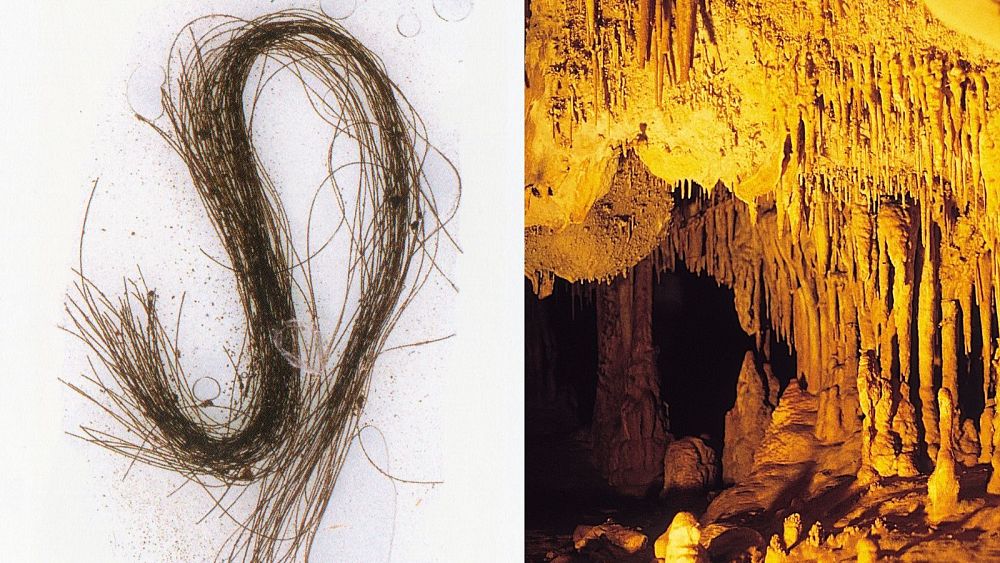3,000-year-old human hair provides first proof of drug use in Europe

Bronze Age homo sapiens could never have imagined that preserving their locks of hair would help Spanish scientists find the oldest direct evidence of drug use in Europe 3,000 years later.
But that’s exactly what happened this month. In a paper published in scientific journal Nature, Dr Elisa Guerra, a researcher from the University of Valladolid, and her team have established that drugs were already being used on the continent three millennia earlier, thanks to evidence from a cave in Menorca, one of Spain’s Balearic islands.
There has been no “direct evidence” of drug use at any other archaeological site in Europe to date. Furthermore, all previous studies “were based on indirect evidence,” says Guerra.
“We knew that prehistoric communities knew about plants with these properties, but we couldn’t be certain that they were using them as drugs,” Guerra told Euronews Next.
All previous knowledge suggesting humans consumed drugs for medicinal or spiritual purposes was based on wild hallucinogenic plants, seeds, or even artistic representations found in some archaeological sites, according to the researchers.
The team that led the study were mostly Spanish scientists with the contribution of an academic from the University of Chile – where the world’s oldest “direct” evidence of drug use so far have been found – and they ran their lab analysis with human hair dating back to around the first millennium BC.
The hairs, which were just 13 cm long, were found in one of the chambers of a cave discovered in the west of Menorca in 1995 called Es Càrritx, considered one of the most important late Bronze Age sites on the island.
They were preserved in cylindrical wooden tubes with lids which scientists link to funerary ritual.
How can drugs be detected in hair?
Hair testing is a widely-accepted technique in the field of forensic toxicology to detect the consumption of certain drugs.
The most common theory as to how drugs end up in our hair is that as drugs circulate in the bloodstream, chemicals are incorporated into the growing hair follicles.
And because psychoactive agents can remain preserved for thousands of years, chemical analysis of human hair from the late Bronze Age cave promised precious insights for Guerra’s team.
The analysis detected the presence of several compounds from the group of Tropane alkaloids known to have hallucinogenic, sedative, and stimulative properties, among them, atropine, scopolamine and ephedrine – all components originating from flora native to Menorca.
Tropane alkaloids are highly psychoactive, exerting multiple effects on the central nervous system.
“Atropine and scopolamine belong to the group of deliriant drugs, ie, they induce delirium characterised by extreme mental confusion, strong and realistic hallucinations, disorientation, alteration of sensorial perception, and behavioral disorganization,” details the report.
“Out-of-body experiences and a feeling of alteration of the skin, as if growing fur or feathers, are usually reported”.
In Europe, these drugs have a long history of use as medicines, poisons, and intoxicants, but they achieved their most notorious reputation in association with European witchcraft during the Middle Ages and the Early Modern period.
On the other hand, ephedrine – the third compoound found in the hair – produces similar effects to adrenaline, such as excitement and enhancement of mental alertness and physical activity.
Drugs used for ceremonial purposes
Based on the results from the hair samples, Guerra is “inclined to concede” the drugs were being used for ritual purposes.
“Although it must be said that in ‘traditional societies,’ it is not so easy to differentiate between what was religion and what was ritual medicine, we do not rule out a therapeutic use,” she said.
“But we believe these drugs may have had a prominent role in ceremonies of a ritual nature,” she said, “ we can’t rule out recreational use either.”
Their theories are based on anthropological studies of the use of plant drugs in other parts of the world, which suggest that these plants often have a religious significance. In fact, many of them are known as “plants of the gods,” she said.
Guerra, who has spent years researching the role of psychoactive substances in European prehistory, believes that the study provides an opportunity to reconsider the relationship of contemporary societies with drugs.
“The media response to our research has given rather biased and unserious interpretations,” the study leader said.
In today’s societies, drug use is used as an escape route from everyday reality, but in ‘traditional societies’, it is completely the opposite, “consumption is part of their culture,” she explained.
Guerra, who is investigating whether “altered states of consciousness” may have played a role in the processes that led to social complexity in the Iberian Peninsula during the Copper Age, believes we should consider the potential benefits of using of these plants.
“Psychiatric studies are demonstrating the beneficial role of some hallucinogens in psychiatric diseases, or the benefits of cannabis in terminal phases of cancer and in diseases related to eating disorders,” she added.
.
Source: Euro News















